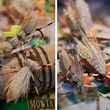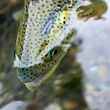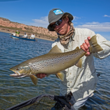I worked my way under a logjam and tried like hell to keep the rainforest stream’s water line below the lip of my chest waders. It was tough going—a younger man’s wading, to be sure.
The shiny and slippery raw wood of an ancient cedar that had fallen during a storm some years back was not something I could confidently walk across, and that meant I had to go under the giant tree in water that was a good four feet deep. The footing beneath me was solid—young karst with jagged edges gripped the rubber soles of my wading boots nicely. But it was deep, and a 40-something isn’t built to bend like that. But I tried anyway, and only once did I feel the chilly, tannin-stained water drip over waders and sneak down my back into my nether regions.
The things we do for fish, right?
But, from the bear trail above me along the stream, I’d found what I believed to be the perfect run for hungry Dollies, and the only way to get to the upstream side of it was to get past the log jam. It wasn’t optional—if I wanted to run a streamer through the sexiest water I’d seen all day, a little water in my crack wasn’t going to stop me.
I made it under the log and bounced along the creek bottom for a few steps until I was able to wade out of the depths and onto the sweet little gravel bar that marked the beginning of the run. As I waded, dozens of pre-spawn pink salmon darted between my legs. In the riffles below me, a few females were clearly scouting potential spawning redds, and I took care to not to disturb much gravel, just in case.
Below the riffle, the stream bottomed out, and got deep in a hurry. The current of the creek kept pushing against an impermeable rock bank that took a hard left and steered the water downstream at just the right speed. Through the tannic water, I could occasionally see the creamy fin-tips of hungry dollies—dozens of them. They were there. They were waiting for the salmon to spawn. And they were hungry.
I tied on a weighted purple ‘bugger, and cast the fly down and across. The tungsten bead got the fly down quickly, and I lost sight of it after just a few feet. Almost immediately, I felt the strike of a hungry char, but my set was late, and I missed the fish. Undeterred, I let it keep swinging. Another strike. Another miss. And another and another. Finally, on the strip back to the bank, I saw the fly swimming nicely in the dark water, and when a 15-inch Dolly hit it, I was able to strip-set and connect.
Fishing blind with traditional searching patterns can be really productive—traditional streamers, like Woolly Buggers, Slumpbusters and the like are staples in waters where predatory fish will strike at almost anything that looks like food under the right circumstances.
But, there in the rainforest of Southeast Alaska’s Tongass National Forest, the Dollies, while eager and aggressive, are also pretty texture-driven. If the “food” they put in their mouths doesn’t feel right, they’ll spit the fly before you get the chance to set the hook.
So, after releasing the fish I caught on the strip, I switched the purple bugger to a very similar Egg-sucking Leech with a bright, UV-sensitive pink head. While I’m sure this improved the visibility of the fly for the fish, the real goal was to give me something to see as the fly cruised through the run on the swing.
I performed the same cast, let the fly drop a bit and then tightened the line on the swing—the bright pink head was visible to me, even through the dark water, and I saw the strike happen almost immediately (and well before I felt it). I stip-set and connected with a beefy 20-inch Dolly that didn’t have the chance to spit the fly.
The lesson was simple. I needed to see the fly as much as the fish did in this instance. Hungry Dollies hate to let food go by unmolested, but they’re into food that feels right. If you can’t set the hook before they realize the fly isn’t really food, your chances of landing one drop significantly. If you can see the strike on the streamer, you can set the hook before the strike makes its way up the line to your rod tip.
A year or two later, while fishing the Bitterroot on a cloudy, blustery spring day just before the sqwala hatch in late March, I waded up to a great run, where I was sure a fat brown was lying in wait. I switched over to a streamer and, just before I made the cast, I remembered my little lesson from the Tongass. I took off the leech pattern I was using and put on a bright, chartreuse ‘bugger with a bit of weight. I made the compulsory cast just above the targeted run and watched the fly start to swing. Within a second or two, I saw the fly simply disappear.
Not waiting for the “strike,” I set the hook and was immediately connected to a really nice 18-inch brown that was staking out the current for anything that looked like food. Had I not seen the fish inhale the fly, there’s a really good chance that I would have missed the fish altogether. And, unlike those feisty Alaska Dollies, the chances of this Montana brown trout hitting the fly a second time were pretty slim.
That’s not to say that every time you fish streamers, it’s important that you see the fly. But, on dark days in dark water, I’ve found that my chances of hooking up with hungry trout—or rainforest char—are greater when I can at least see a portion of the fly. This might fly in the face of the “dark day, dark fly” mantra that I’d have a hard time arguing with, but I’ve had success too many times by simply being able to see what’s happening with my fly as it makes a swing through likely runs.
And you don’t have to go totally bright with the fly—as was the case in Alaska, just the pink head on the ESL was all I needed to let me know when the fish hit the streamer.
The next time you’re swinging big flies for trout, and you’re having hard time hooking up, consider going with something that you’ll be able to see when it’s in the water. It might make the difference between a strike and a miss and a solid hookup with the fish of the day.































Comments